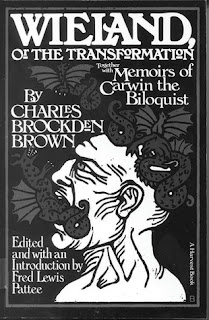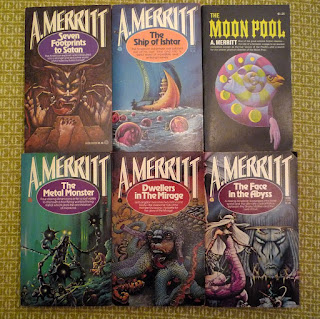 |
| Requires a damned index |
More people have read the Lord of the
Rings novels than have read the History of Middle-Earth books. Based
on that alone, there is a strong argument to be made that people are more interested
in what is going to happen in an unfolding narrative than in what happened in the past of a static narrative, at least when it comes to general engagement with fantasy as a fictional mode.
This matters when it comes to RPG world-building that you want to appeal to and be read by other people. It's often the case that DMs and other world-creators spent
a lot of time lovingly detailing their world's minutiae, back story,
and history; you get things like time lines, essays about fictional
cultures, and walls of text about Elven liturgy whether you want them or not.
And, as it turns out, a lot of people don't seem to want that stuff. Last week on G+ there were two really interesting threads asking about
people's preferences when it comes to detailing the history of
fictional worlds. The majority of people who responded admitted that
they aren't interested in an excess of that stuff—and the degree to which they
weren't interested was pretty well defined and emphatically stated. That might be an artifact of my G+ circles being heavily-weighted toward an OSR perspective; maybe there is a sharper divide between people who prefer heavy text and those that don't, but in any case the dissent against Big Setting is pretty significant even if it might not represent a majority view.
I think I understand why people aren't
interested in page after page of fictional history and paragraph
after paragraph of world-building: it's the DM version of “let me
tell you about my character” magnified without a sense or
proportion or boundaries.
 |
| Don't tell me about this character tho. |
Since the DM's job is “being everything
else” besides the player's characters, the world is essentially the
DM's character; any long-running history of that world is the DM
telling you all about their character, often in unnecessary detail. Dear DM: if you would roll your eyes at a five-page character back story that a player wants you to read, you
should roll your eyes at your own expectation that the players will read five pages about the history of the Cult of
Paradoxis and their war with the fire giants too.
Naturally, the same applies to the hyper-detailed settings you can buy off the rack (especially when that detail is inserted into a core book), except in that case the "DM" is a game designer who doesn't even have the decency to run the game for you. For me, the net effect is the same: whether a big publisher has thirty pages of back story I am supposed to read before I get any actual game in a book or a DM gives me thirty pages of xeroxed setting notes I'm supposed to read before we can play, I've got the same set of objections.
Now, I actually like hearing about
people's characters—but with some caveats: (A) keep it short and
sweet; (B) I want to hear about what makes this character different
and interesting; (C) I want to know more about what they've done in
play than what they've done in the past before play began. These
principles, when violated, are often why I don't want to read all about a
DM's bespoke setting or an excessive published setting from one of the major imprints:
(A) While ten pages of detail on a
city might be useful notes for a DM to have, if you ask me to read
those ten pages before the game actually starts you're giving me
homework when I signed on to have fun. Worse yet, you're actually taking away
the fun of letting me discover the interesting things about the city
while playing the game. Products aimed at DMs should be given some slack here, I think.
(B) A lot of world-builders are kidding
themselves about the uniqueness of the history they've written for
their settings. If it fits into the familiar pattern of “In the
Age of Fire, the dragons rose and gathered these followers, but were
eventually beaten back by the Knights of Gorro, led by the Great
King Fajadhul who founded the city of Dahan in the Year 100030”
you should realize that the words and dates could be swapped out to
create the back story of a million other nondescript fantasy
settings. This is sub-Tolkienism.
(C) People undervalue immediacy
when it comes to game settings. If the important history of the
setting is what just happened, chances are that they player
characters can still get involved in it and push things in
interesting directions. If the history (or, sigh, prehistory) is too
far in the past to interact with, it might shape the setting but it
doesn't really shape play—and therefore the players don't need to
know about it at all. Also, please stop detailing thousands (or tens
of thousands in the most egregious cases) years of history. People
don't tend to have that good a grasp of thousands of years of
real-world history, so they certainly aren't going to make time to
learn that much made-up history—you're going to be disappointed if
that's what you want out of them.
Of course, this doesn't mean that we
need to swing to the extreme of having setting with no history or
sense of past. It definitely doesn't mean that you're a bad person doing a bad thing if you enjoy writing down great swaths of setting material. And it doesn't mean that there is an objective standard as to what constitutes "excessive" setting detail--that's clearly a subjective, individual call. It might mean, however, that we need to rethink the
extent to which we focus on heavy text when world-building and to
reconsider how we deploy information about a setting if we want other people to engage with it.
 |
| Honestly? This isn't even a game book. |
If you want to have the "lonely fun" of writing up every corner of your setting for your own edification--that's one thing. If you want to appeal to that rarer sort of deep-delver that buys a two volume coffee-table Guide to Glorantha and reads it "novelistically," that's another thing. If you're giving the rough outline of your setting in a core product and are saving up all the essays and timelines for the separate setting book that you know will have a smaller audience, that's a reasonable thing. But if you're writing up your setting in glorious detail with the expectation that you'll get a big audience to read your creation as lovingly as you wrote it, I think you're setting yourself up for disappointment.
The point is: you make choices in the presentation of your setting that will tip the level of other people's engagement with it whether you're thinking about it or not, so you might as well think about what you want, the expectations of your audience, and the area of overlap therein.
There are alternatives to the usual textbook-style infodump of delivering setting information still favored by the publishers of traditional RPG books; though the "big book" model still prevails among publishers who have been slow to embrace innovations in design, that lethargy shouldn't be confused with either a successful methodology or a winning standard. These are the best alternatives I've seen so far (and I certainly wouldn't mind seeing more):
- Evocative map with slight-but-engaging setting notes, such Aos of Metal Earth excels at.
- Brief setting documents aimed at conveying a feel rather than encyclopedic knowledge that can either be read by an interested player or safely avoided by a disinterested one with no value lost, such as I've done here for Krevborna.
- Setting information delivered via game system, as Yoon-Suin does.
- Splashy visuals tied to brief-but-tantalizing descriptions that convey setting history, like Trey Causey's Strange Stars.
- Setting information deployed via item descriptions, as Dark Souls and Bloodborne do.
- Setting creation as shared mini-game, as in Beyond the Wall.
- Setting deployed via "news of the world" updates for the players, like Chris Kutalik does for his Hill Cantons games.
- Wikis with short entries, with lots of internal links that can be perused (or not) depending on the reader's desired level of engagement.
- Setting descriptions focused on a brief precis, a slightly more detailed conspectus, and sensory details like sound, tastes, etc. like I did for some of the World Between stuff.
- Jeff Rient's twenty questions is a rapid-fire, get-it-done-and-move-on-let's-play approach.
- Brief compendium entries that are immediately game-able, like the Dictionary of Mu.
Obviously, there is no one-size-fits-all approach that is appropriate to every world-building project and none of the above are foolproof, but it's worthwhile to think about the form for your content if you aren't getting the level of interest you want. It might not be the audience that needs to change--it might be that your invitation to the audience that could use some work.
 K. J. Bishop, The Etched City
K. J. Bishop, The Etched City Drew D. Gray, London's Shadows: The Dark Side of the Victorian City
Drew D. Gray, London's Shadows: The Dark Side of the Victorian City








































